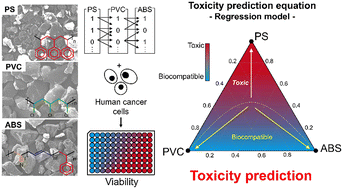Potential threat of microplastics to humans: toxicity prediction modeling by small data analysis†
Abstract
Microplastics are ubiquitous in the environment and continuously interact with humans. Increased plastic production and consumption cause severe plastic pollution, emerging as a global problem. Accordingly, research on the impact of microplastics on humans has been exponentially increasing. However, microplastics are blended and entangled with various types, sizes, and shapes in nature, which is still a limitation to understanding the threat of microplastics to humans by studying single-use plastic. To reflect microplastics in nature, we present a new predictive model to investigate the toxicity of mixed microplastics to human cells. We statistically analyzed a small toxicity data set according to the mixing ratio of three different types of microplastics: polystyrene (PS), polyvinyl chloride (PVC), and acrylonitrile butadiene styrene (ABS). Using the model, we could successively predict the toxicity of a wide range of mixing ratios with a reliable prediction performance. Also, the toxicity is highly dependent on the number of plastics rather than hydrophobicity, functional groups, and surface roughness. We strongly believe that this model design offers prospects for a new platform to realistically predict the toxicity of microplastics to humans.



 Please wait while we load your content...
Please wait while we load your content...